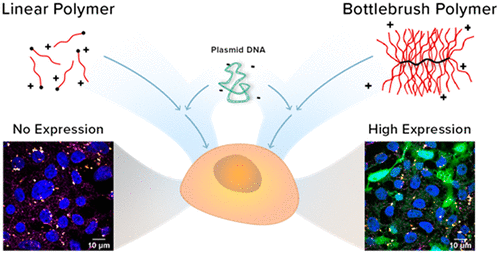当前位置:
X-MOL 学术
›
ACS Macro Lett.
›
论文详情
Our official English website, www.x-mol.net, welcomes your
feedback! (Note: you will need to create a separate account there.)
Cationic Bottlebrush Polymers Outperform Linear Polycation Analogues for pDNA Delivery and Gene Expression
ACS Macro Letters ( IF 5.1 ) Pub Date : 2021-06-25 , DOI: 10.1021/acsmacrolett.1c00335 Rishad J Dalal 1 , Ramya Kumar 1 , Monica Ohnsorg 1 , Mary Brown 2 , Theresa M Reineke 1
ACS Macro Letters ( IF 5.1 ) Pub Date : 2021-06-25 , DOI: 10.1021/acsmacrolett.1c00335 Rishad J Dalal 1 , Ramya Kumar 1 , Monica Ohnsorg 1 , Mary Brown 2 , Theresa M Reineke 1
Affiliation

|
Cationic polymer vehicles have emerged as promising platforms for nucleic acid delivery because of their scalability, biocompatibility, and chemical versatility. Advancements in synthetic polymer chemistry allow us to precisely tune chemical functionality with various macromolecular architectures to increase the efficacy of nonviral-based gene delivery. Herein, we demonstrate the first cationic bottlebrush polymer-mediated pDNA delivery by comparing unimolecular, synthetically defined bottlebrush polymers to their linear building blocks. We successfully synthesized poly(2-(dimethylamino)ethyl methacrylate) (pDMAEMA) bottlebrushes through ring-opening metathesis polymerization to afford four bottlebrush polymers with systematic increases in backbone degree of polymerization (Nbb = 13, 20, 26, and 37), while keeping the side-chain degree of polymerization constant (Nsc = 57). Physical and chemical properties were characterized, and subsequently, the toxicity and delivery efficiency of pDNA into HEK293 cells were evaluated. The bottlebrush-pDNA complex (bottleplex) with the highest Nbb, BB_37, displayed up to a 60-fold increase in %EGFP+ cells in comparison to linear macromonomer. Additionally, we observed a trend of increasing EGFP expression with increasing polymer molecular weight. Bottleplexes and polyplexes both displayed high pDNA internalization as measured via payload enumeration per cell; however, quantitative confocal analysis revealed that bottlebrushes were able to shuttle pDNA into and around the nucleus more successfully than pDNA delivered via linear analogues. Overall, a canonical cationic monomer, such as DMAEMA, synthesized in the form of cationic bottlebrush polymers proved to be far more efficient in functional pDNA delivery and expression than linear pDMAEMA. This work underscores the importance of architectural modifications and the potential of bottlebrushes to serve as effective biomacromolecule delivery vehicles.
中文翻译:

阳离子瓶刷聚合物在 pDNA 递送和基因表达方面优于线性聚阳离子类似物
阳离子聚合物载体因其可扩展性、生物相容性和化学多功能性而成为有前途的核酸递送平台。合成聚合物化学的进步使我们能够使用各种大分子结构精确调整化学功能,以提高基于非病毒的基因传递的功效。在这里,我们通过比较单分子、合成定义的瓶刷聚合物与其线性结构单元,展示了第一个阳离子瓶刷聚合物介导的 pDNA 递送。我们通过开环复分解聚合成功合成了聚(2-(二甲基氨基)甲基丙烯酸乙酯)(pDMAEMA)瓶刷,得到了四种主链聚合度系统性增加的瓶刷聚合物(N bb= 13、20、26 和 37),同时保持侧链聚合度恒定 ( N sc = 57)。对物理和化学性质进行了表征,随后评估了 pDNA 进入 HEK293 细胞的毒性和递送效率。具有最高N bb的瓶刷-pDNA 复合体 (bottleplex), BB_37,与线性大单体相比,%EGFP+ 细胞增加了 60 倍。此外,我们观察到随着聚合物分子量的增加,EGFP 表达增加的趋势。通过每个细胞的有效载荷枚举来衡量,Bottleplexes 和 polyplexes 都显示出高 pDNA 内化;然而,定量共聚焦分析表明,与通过线性类似物传递的 pDNA 相比,瓶刷能够更成功地将 pDNA 穿梭于细胞核中和细胞核周围。总体而言,以阳离子瓶刷聚合物的形式合成的典型阳离子单体,如 DMAEMA,在功能性 pDNA 递送和表达方面证明比线性 pDMAEMA 更有效。
更新日期:2021-07-20
中文翻译:

阳离子瓶刷聚合物在 pDNA 递送和基因表达方面优于线性聚阳离子类似物
阳离子聚合物载体因其可扩展性、生物相容性和化学多功能性而成为有前途的核酸递送平台。合成聚合物化学的进步使我们能够使用各种大分子结构精确调整化学功能,以提高基于非病毒的基因传递的功效。在这里,我们通过比较单分子、合成定义的瓶刷聚合物与其线性结构单元,展示了第一个阳离子瓶刷聚合物介导的 pDNA 递送。我们通过开环复分解聚合成功合成了聚(2-(二甲基氨基)甲基丙烯酸乙酯)(pDMAEMA)瓶刷,得到了四种主链聚合度系统性增加的瓶刷聚合物(N bb= 13、20、26 和 37),同时保持侧链聚合度恒定 ( N sc = 57)。对物理和化学性质进行了表征,随后评估了 pDNA 进入 HEK293 细胞的毒性和递送效率。具有最高N bb的瓶刷-pDNA 复合体 (bottleplex), BB_37,与线性大单体相比,%EGFP+ 细胞增加了 60 倍。此外,我们观察到随着聚合物分子量的增加,EGFP 表达增加的趋势。通过每个细胞的有效载荷枚举来衡量,Bottleplexes 和 polyplexes 都显示出高 pDNA 内化;然而,定量共聚焦分析表明,与通过线性类似物传递的 pDNA 相比,瓶刷能够更成功地将 pDNA 穿梭于细胞核中和细胞核周围。总体而言,以阳离子瓶刷聚合物的形式合成的典型阳离子单体,如 DMAEMA,在功能性 pDNA 递送和表达方面证明比线性 pDMAEMA 更有效。











































 京公网安备 11010802027423号
京公网安备 11010802027423号